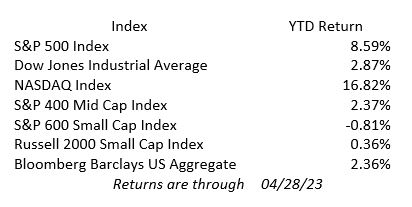Banking system stress is in the headlines again following the failure of First Republic Bank (FRC), which surpassed Silicon Valley Bank (SVB) as the second largest bank failure in U.S. history with over $230B in assets at the end of the first quarter. The bank had been teetering on the brink of collapse for weeks following SVB’s failure, despite additional support from regulators and a $30 billion deposit injection from a group of large banks. The FDIC seized FRC on Friday and sold the bulk of its operations to JP Morgan over the weekend. Having said that, the Dow Jones industrial average was up 0.9% for the week and 2.5% for the month. The S&P 500 followed suit gaining 0.9% for the week and 1.5% for the month. The NASDAQ was up 1.28% for the week and basically unchanged for the month. Mid-Caps and Small-Caps for the week dropped 0.44% and 1.03% respectively.
First Republic Bank’s failure echoed many of the issues seen by Silicon Valley Bank and Signature Bank that contributed to their downfalls in the wake of the Federal Reserve’s aggressive rate hikes. The San Francisco-based bank had a unique focus, catering to wealthy coastal borrowers with large fixed-rate mortgages and other private wealth services. Their business model resulted in a concentrated depositor base that was only about 20% the size of what other banks of similar scale had, according to a January investor presentation. Additionally, 68% of those deposits exceeded the FDIC insurance limits at the end of 2022. Finally, while many banks have diversified loan books including both variable and fixed rate loans, a large proportion of FRC’s loan book (nearly 60%) was in single-family mortgages, many of which were low fixed-rate, long-term loans that suffered large market value declines with rising market rates. These issues culminated in a dismal first quarter earnings report last week before being placed into receivership in which First Republic reported a $72 billion decline in deposits (even after the $30B deposit injection from other banks) and a significant resulting increase in costly borrowing that would largely exceed the yield on its assets. While many banks reported deposit pressures in the first quarter, deposit outflows were generally much more modest and stabilizing at the end of the quarter.
On the economic front, the U.S. employment cost index gained 1.2% for the first quarter following a similar increase of 1.1% in 4Q22. The employment cost index is one of the Fed’s preferred inflation gages. Initial unemployment claims came in at 230K, 20k short of the expected 250K, along with being lower than the previous week of 246k.
U.S. GDP showed a 1Q increase of 1.1% quarter-over-quarter and 1.6% year-over-year. Both are preliminary numbers. New home sales for March were 683K, which was 53K higher than expected.
Earnings season is here. As of Thursday, April 27, almost half the companies in the S&P 500 had reported Q1 results. Nearly 82% of reporters had beaten consensus EPS estimate, which is above both the one-year average of 73% and the five-year average of 77%. Some of those companies include Alphabet (parent company of Google), Microsoft, and Meta Platforms (formerly Facebook) which all came in above expectations.
All eyes will be on the Fed meeting Wednesday May 3 to see if they raise interest rates or hold where they are. If they do raise rates, consensus is that they will raise 25 bps. Earlier in the month Jay Powell indicated a possible pause at the May meeting. While the talk from many economists is that there will be multiple cuts later this year, the Fed guidance does not forecast rate cuts until 2024.
The economic calendar is full this week. Besides the Fed meeting, we will see more on employment and payroll. Durable goods orders are expected to be flat from the previous month and productivity for the first quarter is expected to drop. The unemployment rate is expected to come in just a little higher for the month of April.


